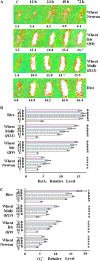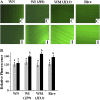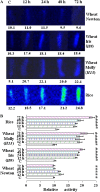Reactive oxygen species are involved in plant defense against a gall midge
- PMID: 19965963
- PMCID: PMC2815885
- DOI: 10.1104/pp.109.150656
Reactive oxygen species are involved in plant defense against a gall midge
Abstract
Reactive oxygen species (ROS) play a major role in plant defense against pathogens, but evidence for their role in defense against insects is still preliminary and inconsistent. In this study, we examined the potential role of ROS in defense of wheat (Triticum aestivum) and rice (Oryza sativa) against Hessian fly (Mayetiola destructor) larvae. Rapid and prolonged accumulation of hydrogen peroxide (H(2)O(2)) was detected in wheat plants at the attack site during incompatible interactions. Increased accumulation of both H(2)O(2) and superoxide was detected in rice plants during nonhost interactions with the larvae. No increase in accumulation of either H(2)O(2) or superoxide was observed in wheat plants during compatible interactions. A global analysis revealed changes in the abundances of 250 wheat transcripts and 320 rice transcripts encoding proteins potentially involved in ROS homeostasis. A large number of transcripts encoded class III peroxidases that increased in abundance during both incompatible and nonhost interactions, whereas the levels of these transcripts decreased in susceptible wheat during compatible interactions. The higher levels of class III peroxidase transcripts were associated with elevated enzymatic activity of peroxidases at the attack site in plants during incompatible and nonhost interactions. Overall, our data indicate that class III peroxidases may play a role in ROS generation in resistant wheat and nonhost rice plants during response to Hessian fly attacks.
Figures





Similar articles
-
Changes in phytohormones and fatty acids in wheat and rice seedlings in response to Hessian fly (Diptera: Cecidomyiidae) infestation.J Econ Entomol. 2011 Aug;104(4):1384-92. doi: 10.1603/ec10455. J Econ Entomol. 2011. PMID: 21882708
-
Hessian fly larval feeding triggers enhanced polyamine levels in susceptible but not resistant wheat.BMC Plant Biol. 2015 Jan 16;15:3. doi: 10.1186/s12870-014-0396-y. BMC Plant Biol. 2015. PMID: 25592131 Free PMC article.
-
Antioxidant defense response in a galling insect.Proc Natl Acad Sci U S A. 2007 Feb 6;104(6):1889-94. doi: 10.1073/pnas.0604722104. Epub 2007 Jan 29. Proc Natl Acad Sci U S A. 2007. PMID: 17261812 Free PMC article.
-
Gall midges (Hessian flies) as plant pathogens.Annu Rev Phytopathol. 2012;50:339-57. doi: 10.1146/annurev-phyto-072910-095255. Epub 2012 May 29. Annu Rev Phytopathol. 2012. PMID: 22656645 Review.
-
Class III plant peroxidases: From classification to physiological functions.Int J Biol Macromol. 2024 Apr;263(Pt 1):130306. doi: 10.1016/j.ijbiomac.2024.130306. Epub 2024 Feb 20. Int J Biol Macromol. 2024. PMID: 38387641 Review.
Cited by
-
Pseudomonas syringae enhances herbivory by suppressing the reactive oxygen burst in Arabidopsis.J Insect Physiol. 2016 Jan;84:90-102. doi: 10.1016/j.jinsphys.2015.07.011. Epub 2015 Jul 21. J Insect Physiol. 2016. PMID: 26205072 Free PMC article.
-
Enhanced aphid detoxification when confronted by a host with elevated ROS production.Plant Signal Behav. 2015;10(4):e1010936. doi: 10.1080/15592324.2015.1010936. Plant Signal Behav. 2015. PMID: 25932782 Free PMC article.
-
Jasmonic Acid-Treated Cotton Plant Leaves Impair Larvae Growth Performance, Activities of Detoxification Enzymes, and Insect Humoral Immunity of Cotton Bollworm.Neotrop Entomol. 2022 Aug;51(4):570-582. doi: 10.1007/s13744-022-00970-x. Epub 2022 Jun 9. Neotrop Entomol. 2022. PMID: 35680779
-
Identification of a Novel Nematotoxic Protein by Challenging the Model Mushroom Coprinopsis cinerea with a Fungivorous Nematode.G3 (Bethesda). 2015 Nov 19;6(1):87-98. doi: 10.1534/g3.115.023069. G3 (Bethesda). 2015. PMID: 26585824 Free PMC article.
-
A B-Box (BBX) Transcription Factor from Cucumber, CsCOL9 Positively Regulates Resistance of Host Plant to Bemisia tabaci.Int J Mol Sci. 2025 Jan 2;26(1):324. doi: 10.3390/ijms26010324. Int J Mol Sci. 2025. PMID: 39796180 Free PMC article.
References
-
- Anderson KG, Harris MO (2006) Does R gene resistance allow wheat to prevent plant growth effects associated with Hessian fly (Diptera: Cecidomyiidae) attack? J Econ Entomol 99 1842–1853 - PubMed
-
- Apel K, Hirt H (2004) Reactive oxygen species: metabolism, oxidative stress, and signal transduction. Annu Rev Plant Biol 55 373–399 - PubMed
-
- Asada K, Takahashi M (1987) Production and scavenging of active oxygen in photosynthesis. In DJ Kyle, CB Osmond, CJ Amtzen, eds, Photoinhibition (Topics in Photosynthesis), Vol 9. Elsevier, Amsterdam, pp 227–287
-
- Benjamini Y, Hochberg Y (1995) Controlling the false discovery rate: a practical and powerful approach to multiple testing. J R Stat Soc B 57 289–300
-
- Bentur JS, Kalode MB (1996) Hypersensitive reaction and induced resistance in rice against the Asian rice gall midge Orseolia oryzae. Entomol Exp Appl 78 77–81
MeSH terms
Substances
LinkOut - more resources
Full Text Sources

